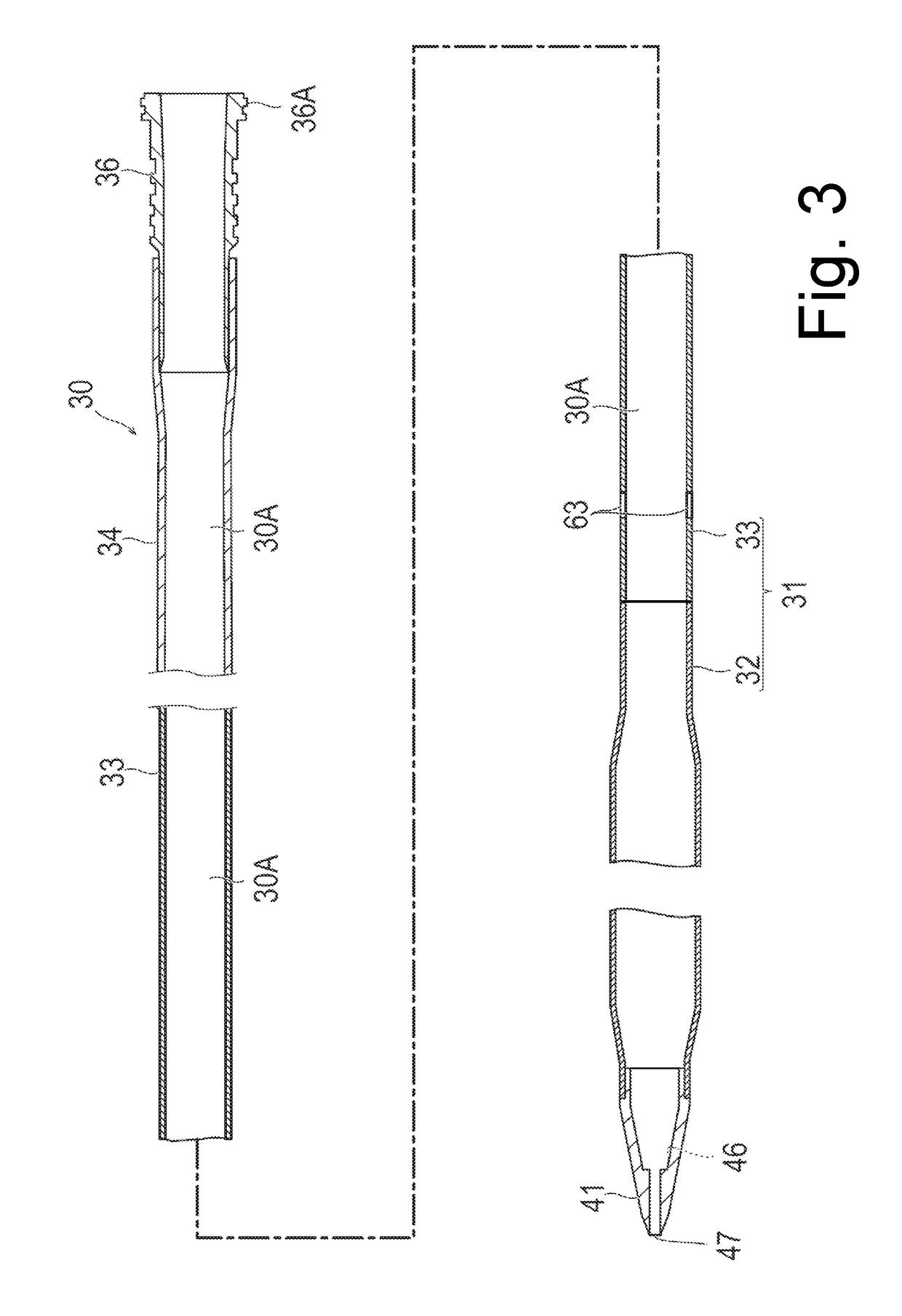Percutaneous catheter and method of manufacturing tube for percutaneous catheter
a manufacturing method and technology for percutaneous catheters, applied in the field of percutaneous catheters and manufacturing methods of percutaneous catheters, can solve the problems of kink generation, complicated manufacturing steps, and deterioration of the performance of being inserted into a living body, and achieve the effects of reducing the likelihood of kink in the part provided with the side hole, reducing manufacturing costs, and increasing rigidity
- Summary
- Abstract
- Description
- Claims
- Application Information
AI Technical Summary
Benefits of technology
Problems solved by technology
Method used
Image
Examples
first embodiment
[0040]With reference to FIGS. 2 to 7, a percutaneous catheter (which will hereinafter be referred to as a “catheter”) 30 according to a first embodiment of the present invention will be described. FIGS. 2 to 7 are views describing a configuration of the catheter 30 according to the first embodiment. The catheter 30 according to the present embodiment is used as the vein side catheter (catheter for blood removing) 5 in FIG. 1.
[0041]As illustrated in FIG. 2, the catheter 30 according to the present embodiment has a catheter tube (corresponding to a tube for a percutaneous catheter) 31 which includes a side hole (corresponding to a side hole on a proximal side) 63, a distal tip 41 which is disposed at a distal end of the catheter tube 31 and includes through-holes 46 and 47, a clamping tube 34 which is disposed on the proximal side of the catheter tube 31, a catheter connector 35 which connects the catheter tube 31 and the clamping tube 34 to each other, and a lock connector 36.
[0042]I...
second embodiment
[0129]With reference to FIG. 12, a percutaneous catheter (which will hereinafter be referred to as a “catheter”) 230 according to a second embodiment of the present invention will be described. FIG. 12(A) is a side view illustrating the distal side of the catheter 230, and FIG. 12(B) is a side view illustrating a situation in which the dilator 50 is inserted into the catheter 230.
[0130]Similar to the first embodiment, the catheter 230 according to the second embodiment has a catheter tube (corresponding to a tube for a percutaneous catheter) 231. The catheter tube 231 includes a first tube 232 and the second tube 33 disposed on the proximal side of the first tube 232. The first tube 232 is configured to have higher flexibility than that of the second tube 33.
[0131]As illustrated in FIG. 12(A), the catheter 230 differs from the first embodiment in further including a side hole 263 on the distal side in the first tube 232. The same reference signs are applied to portions having the sa...
third embodiment
[0137]With reference to FIGS. 13 to 15, a percutaneous catheter (which will hereinafter be referred to as a “catheter”) 60 according to the third embodiment of the present invention will be described.
[0138]A catheter 60 is a so-called double lumen catheter, which can perform both blood feeding and blood removing at the same time. Therefore, in the present embodiment, for the extracorporeal circulator 1 in FIG. 1, a technique is performed by using only the catheter 60, without using two catheters, that is, the vein side catheter (catheter for blood removing) 5 and the artery side catheter (catheter for blood feeding) 6.
[0139]As illustrated in FIG. 14, the catheter 60 according to the present embodiment differs from the catheter 30 according to the first embodiment in that a third tube 161 including a first lumen 61 communicating with a side hole (corresponding to a side hole on the proximal side) 163 for blood feeding has a double tube structure disposed in the lumen of the second tu...
PUM
| Property | Measurement | Unit |
|---|---|---|
| length | aaaaa | aaaaa |
| length | aaaaa | aaaaa |
| diameter | aaaaa | aaaaa |
Abstract
Description
Claims
Application Information
 Login to View More
Login to View More - R&D
- Intellectual Property
- Life Sciences
- Materials
- Tech Scout
- Unparalleled Data Quality
- Higher Quality Content
- 60% Fewer Hallucinations
Browse by: Latest US Patents, China's latest patents, Technical Efficacy Thesaurus, Application Domain, Technology Topic, Popular Technical Reports.
© 2025 PatSnap. All rights reserved.Legal|Privacy policy|Modern Slavery Act Transparency Statement|Sitemap|About US| Contact US: help@patsnap.com



